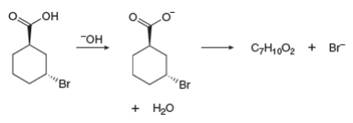
ORGANIC CHEMISTRY W/CONNECT & ALEKS
6th Edition
ISBN: 9781264683888
Author: SMITH
Publisher: MCG
expand_more
expand_more
format_list_bulleted
Concept explainers
Textbook Question
Chapter 7, Problem 68P
When a single compound contains both a nucleophile and a leaving group, an intramolecular reaction may occur. With this in mind, draw the product of the following reaction.

Expert Solution & Answer
Want to see the full answer?
Check out a sample textbook solution
Students have asked these similar questions
In the following molecule, indicate the hybridization and shape of the indicated atoms.
-z:
CH3
CH3
H3C
HO:
CI:
:
Q3: Draw the Lewis structures for nitromethane (CH3NO2) and methyl nitrite (CH3ONO). Draw at
least two resonance forms for each. Determine which form for each is the major resonance
contributor.
Page 1 of 4
Chem 0310 Organic Chemistry 1 Recitations
Q4: Draw the Lewis structures for the cyanate ion (OCN) and the fulminate ion (CNO-). Draw all
possible resonance structures for each. Determine which form for each is the major resonance
contributor.
Metallic clusters and nanomaterials.
Chapter 7 Solutions
ORGANIC CHEMISTRY W/CONNECT & ALEKS
Ch. 7.1 - Problem 7.1 Telfairine, a naturally occurring...Ch. 7.2 - Give the IUPAC name for each compound. a. b. c. d.Ch. 7.2 - Prob. 3PCh. 7.3 - An sp3 hybridized CCl bond is more polar than an...Ch. 7.4 - Prob. 5PCh. 7.6 - Prob. 6PCh. 7.7 - Prob. 10PCh. 7.8 - Prob. 15PCh. 7.8 - Prob. 16PCh. 7.8 - Prob. 17P
Ch. 7.11 - Prob. 18PCh. 7.11 - Prob. 19PCh. 7.11 - Draw the product of each SN2 reaction and indicate...Ch. 7.11 - Prob. 21PCh. 7.11 - Prob. 22PCh. 7.12 - What happens to the rate of an SN1 reaction under...Ch. 7.12 - Draw the products of each SN1 reaction and...Ch. 7.13 - Classify each carbocation as 1,2, or 3. a. b. c....Ch. 7.15 - Problem 7.30 For each alkyl halide and...Ch. 7.15 - Prob. 30PCh. 7.15 - Prob. 31PCh. 7.15 - Prob. 32PCh. 7.15 - Prob. 33PCh. 7.15 - Prob. 34PCh. 7 - Give the IUPAC name for each compound, including...Ch. 7 - Draw the products of each nucleophilic...Ch. 7 - Prob. 50PCh. 7 - Prob. 51PCh. 7 - 7.53 Consider the following reaction.
Draw a...Ch. 7 - Prob. 57PCh. 7 - Prob. 58PCh. 7 - Consider the following SN1 reaction. a.Draw a...Ch. 7 - 7.59 Pick the reactant or solvent in each part...Ch. 7 - Draw the products of each SN1 reaction and...Ch. 7 - Prob. 62PCh. 7 - Prob. 63PCh. 7 - Draw a stepwise, detailed mechanism for the...Ch. 7 - When a single compound contains both a nucleophile...Ch. 7 - Prob. 69PCh. 7 - Prob. 70PCh. 7 - Draw a stepwise, detailed mechanism f or the...Ch. 7 - Prob. 72PCh. 7 - Prob. 78P
Additional Science Textbook Solutions
Find more solutions based on key concepts
The validity of a scientific law.
Physical Universe
Why is it unlikely that two neighboring water molecules would be arranged like this?
Campbell Biology (11th Edition)
What were the major microbiological interests of Martinus Beijerinck and Sergei Winogradsky? It can be said tha...
Brock Biology of Microorganisms (15th Edition)
Separate the list P,F,V,,T,a,m,L,t, and V into intensive properties, extensive properties, and nonproperties.
Fundamentals Of Thermodynamics
Why are mutants used as test organisms in the Ames test?
Laboratory Experiments in Microbiology (12th Edition) (What's New in Microbiology)
Knowledge Booster
Learn more about
Need a deep-dive on the concept behind this application? Look no further. Learn more about this topic, chemistry and related others by exploring similar questions and additional content below.Similar questions
- 55. The photoelectric threshold energy for ytterbium metal is 4.16 × 10-19 J/atom. a. Calculate the wavelength of light that this energy corresponds to (in nm). b. Which region of the electromagnetic spectrum does this wavelength fall in? c. Would light of wavelength 490 nm produce a photoelectric effect in ytterbium? Why or why not?arrow_forward14.50 Explain why methyl vinyl ether (CH2=CHOCH 3) is not a reactive dienophile in the Diels-Alder reaction.arrow_forwardShow work with explanation needed. don't give Ai generated solutionarrow_forward
- 14.49 From what you have learned about the reaction of conjugated dienes in Section 14.10, predict the products of each of the following electrophilic additions. a. H₂O H2SO4 Br2 b. H₂Oarrow_forward14.46 Draw a stepwise mechanism for the following reaction. HBr ROOR Br + Brarrow_forwardShow work..don't give Ai generated solution....arrow_forward
- 14.47 Addition of HCI to alkene X forms two alkyl halides Y and Z. exocyclic C=C X HCI CI Y + CI Z a. Label Y and Z as a 1,2-addition product or a 1,4-addition product. b.Label Y and Z as the kinetic or thermodynamic product and explain why. c. Explain why addition of HCI occurs at the indicated C=C (called an exocyclic double bond), rather than the other C=C (called an endocyclic double bond).arrow_forward14.44 Ignoring stereoisomers, draw all products that form by addition of HBr to (E)-hexa-1,3,5-triene.arrow_forwardInclude stereochemistry Leven though the solutions manual does 14.43 Draw the products formed when each compound is treated with one not) equivalent of HBr. a. b. C.arrow_forward
arrow_back_ios
SEE MORE QUESTIONS
arrow_forward_ios
Recommended textbooks for you
 Organic Chemistry: A Guided InquiryChemistryISBN:9780618974122Author:Andrei StraumanisPublisher:Cengage Learning
Organic Chemistry: A Guided InquiryChemistryISBN:9780618974122Author:Andrei StraumanisPublisher:Cengage Learning Organic ChemistryChemistryISBN:9781305580350Author:William H. Brown, Brent L. Iverson, Eric Anslyn, Christopher S. FootePublisher:Cengage Learning
Organic ChemistryChemistryISBN:9781305580350Author:William H. Brown, Brent L. Iverson, Eric Anslyn, Christopher S. FootePublisher:Cengage Learning

Organic Chemistry: A Guided Inquiry
Chemistry
ISBN:9780618974122
Author:Andrei Straumanis
Publisher:Cengage Learning

Organic Chemistry
Chemistry
ISBN:9781305580350
Author:William H. Brown, Brent L. Iverson, Eric Anslyn, Christopher S. Foote
Publisher:Cengage Learning
How to Design a Total Synthesis; Author: Chemistry Unleashed;https://www.youtube.com/watch?v=9jRfAJJO7mM;License: Standard YouTube License, CC-BY